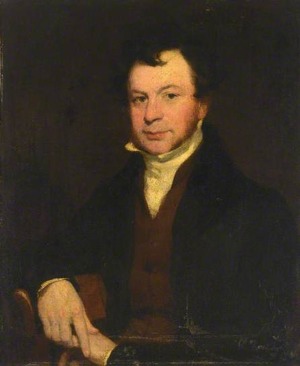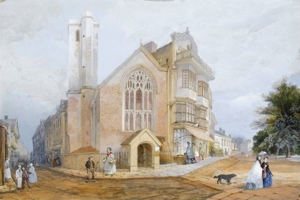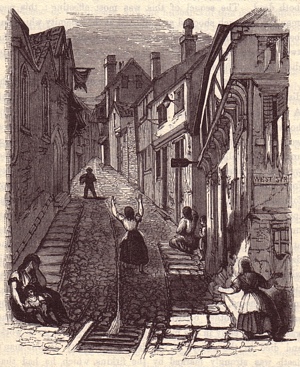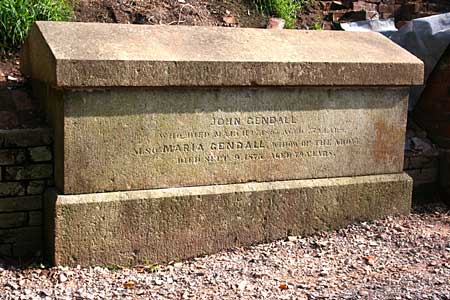
John Gendall - artist
Page updated 8th January 2013
Return to Exeter People Menu
Many of the ancient and mediaeval buildings of Exeter that were demolished between 1810 and 1865 would have gone unrecorded, but for the artistic efforts of John Gendall. Born on Exe Island in 1789, and baptised 2nd January 1790, Gendall was a talented artist who never tired of recording the buildings and streets of Exeter. He often specialised in drawing those buildings that were marked for destruction. He started his working life as a servant for James White a Lincoln's Inn barrister, of Exeter, and friend of Francis Towne, a well established Exeter artist. Charles Cole, a gilder and carver, opened a shop in the High Street where some of Gendall's early drawings were on display. It is probable that one of Rudolph Ackerman's saleman noticed his work and brought Gendall's talent to the attention of his boss.
In 1811, White introduced Gendall to the architect Sir John Soane who commissioned him to draw a window at Westminster Abbey. In the same year, Gendall started working for Ackerman in his printing and engraving business in London. Gendall became the firms manager, was an illustrator and draughtsman of aquatint engravings, and a developer of the new art of lithography. Ackerman's produced work of the highest standard, and coloured lithographs from his artists are some of the finest produced at that time. Between 1817 and 1819, Gendall worked on a series of London views which were published as aquatints. His watercolour sketches of 1820 taken from Augustus Charles Pugin and a sketching tour of Normandy led to the publication of a 'Picturesque tour of the Seine from Paris to the Sea'. Gendall also worked in Hastings, Dover, Calais and in 1824, Edinburgh. He produced a series of watercolour views of country houses for Ackerman's Repository of Art between 1819 and 1827, which were published in 'Views of Country Seats' of 1830.
In 1824, Gendall travelled in the West Country for Ackerman, working on drawings of houses, including Nutwell Lodge as part of the aforementioned Country Seats collection. In 1825 Gendall returned to Exeter and joined a now ageing Charles Cole, in partnership. By 1832, Gendall was ready to dissolve the partnership to allow Cole to retire, but a downturn in business, due to the Cholera outbreak led to the partnership becoming insolvent before the arrangements could be made. In 1834, Gendall moved into Mol's Coffee House where he traded for the next 30 years. Gendall ran a framing, carving and gilding business, sold prints and paintings, initially from one room, and then in 1835, occupied the whole of the building. He ran drawing classes in Cathedral Close; one of Gendall's friends and private student was Richard Ford, the noted hispanophile, and Gendall's watercolour of Ford's Heavitree House, is the only record of what was, by all accounts, a fine building that has since been demolished. Some think that it was Gendall who painted the coats of arms of Devon families that can be found in Mol's. In 1834, he published a series of etchings of Exeter and in 1850, six lithographs of Bicton Church.
Thomas Shapter, the doctor who documented the 1832 Cholera outbreak in 1848 invited Gendall to provide some illustrations for the report and was pleased to include "these interesting sketches of old parts of Exeter." in his book.
Exeter was fast becoming a centre of the arts in the south-west with the Exeter Literary Society and the Devon and Exeter Institution flourishing. The Art Society had its first exhibition in 1845 with Gendall donating works by Opie and Sharland, as well as his own paintings. The next year, Gendall had A Scene on the Avon, Dartmoor accepted by the Royal Academy, and hence became a regular exhibitor.
In 1854 the School of Art, which some believe to be the founding institution of Exeter University, was opened in Queen Street, aided and encouraged by Gendall. At a meeting in 1861 to discuss the creation of what would become the Royal Albert Memorial Museum, Gendall made the point that William Cotton of Ivybridge had given his collection of art to Plymouth because Exeter lacked a museum in which to display it. Gendall was appointed, along with Dr William Scott as the first curator of the new museum, charged with collecting items before the building was complete. John Gendall was also a friend of J V Somers Cocks, the noted expert and enthusiastic collector of Devon prints, many of which are now held by Exeter University.
In 1861, he was listed, along with his wife Maria, in business as a landscape painter, carver and gilder, employing 7 men and 4 boys. By 1864 he was suffering from poor health after he was involved in a railway accident that left him with a partially paralysed right hand.
John Gendall died at the age of 74 on 1st March 1865 and was buried in the cemetery below All Hallows on the city wall in the north of the city. His wife continued the business for a few months, only to put up for sale some 200 hundred of her husbands painting and drawings. The Western Times reported on this last exhibition.
THE LATE JOHN GENDALL. The works of this modest and genuine man, lately deceased, are now on exhibition at the Public Rooms. They will astonish even his most intimate friends from their number and variety of talent. We have only had a momentary glance at them, collectively as it were : and we can truly say it was a most agreeable surprise. His industry has even surpassed all that we had imagined of it. Blessed with a vigorous frame, an unexampled power of work, and a love of nature, which, like Desdemona's appetite, ever grew with the feeding thereof, you would fancy that you see before you the fruits of a sole life. These works must have been accumulated from a special love for them—for Gendall's pictures always sold, and now that the last chance is presented to his admirers of buying direct, there seams to be a rush to posses some relic of tho good man departed, whose fame will grow as his life passes into tradition, and the value of his pictures will augment with the contemplation of their worth. He shines here a master of his art. Of late years we have chiefly known him for his river scenes. He haunted the tangled glens of our brawling water courses, giving us the running water fighting its way over obstructive boulders, the dripping moss, the creeping light stealing through the gnarled and interlacing foliage, the hoary banks and the rich verdure of our genial clime. But on the walls of the Subscription Room we see soft delicious offsets of declining sunlight, the radiance of day, or the mild glow of evening summer, as calm as infant sleeping and beautiful as youth. Every picture is a poem in feeling and expression. But John Gendall, much as he loved the woodlands wild, could enjoy the venerable architecture of old cities, and gives us quaint views of Continental towns and their venerable churches. We gather this at a glance merely, and when we state that the works of this true artist fill the hanging space and centre of the large Hall in which they are exhibited, we need not assure our readers that an exhibition as great as it is unique in character awaits the lover of art, and we hope that every devoté within reach will visit it.
An appeal was printed in the Flying Post to raise money to purchase examples of his work for the city, by the sculptor E B Stephens, the creator of the Deer Stalker in Northernhay Park, and a past pupil of John Gendall. The appeal was not successful, and the RAMM eventually acquired examples of one of Exeter's finest artists from more recent bequests. See Somers Cocks illustrations 756 and 902.
 John Gendall - Copyright the Royal Albert Memorial Museum.
John Gendall - Copyright the Royal Albert Memorial Museum.  St Martin's Church and Mol's Coffee House by John Gendall.
St Martin's Church and Mol's Coffee House by John Gendall.  Stepcote Hill by John Gendall.
Stepcote Hill by John Gendall.  Gendall's grave at the Lower All Hallow's Cemetery, Bartholomew Street.
Gendall's grave at the Lower All Hallow's Cemetery, Bartholomew Street.
│ Top of Page │